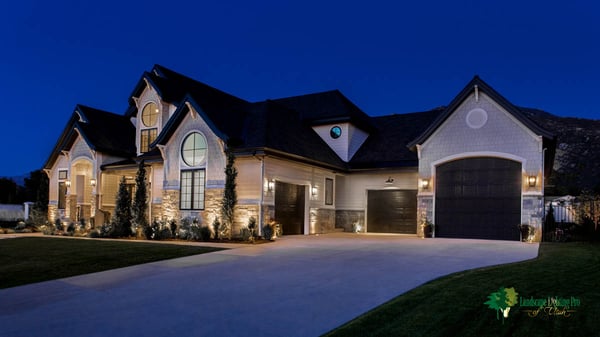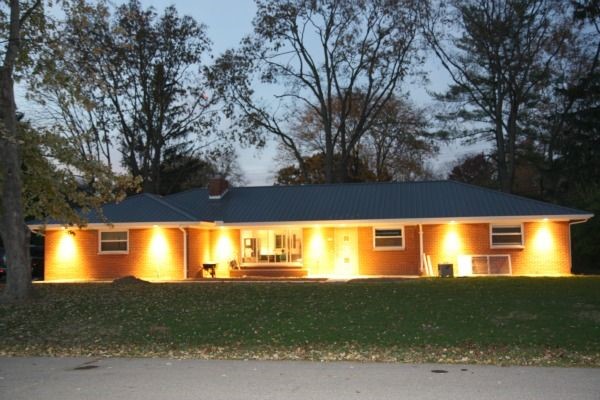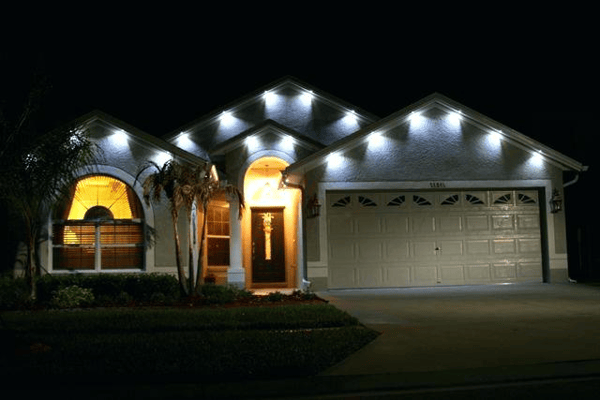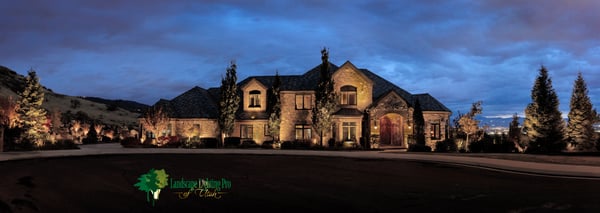Recessed soffit lights: Why up lighting is the better alternative
For many, exterior soffit lights have become a popular way to lite a home’s architecture.
In this post, we discuss the alternative ways to have a beautifully lit home.
Casting light on your home’s architecture can do wonders for your property’s curb appeal. Who doesn’t want a beautifully illuminated home in the evening?
Even though soffit lighting has become quite common, there are plenty of times when this lighting approach doesn’t make the best sense from a design standpoint.

Why are exterior soffit lights so popular?
If exterior soffit lighting isn’t the best design choice, why is it so popular?
One of the advantages of soffit lighting is that it does provide a functional light source to see by that also casts light onto a home’s architecture.
In other words, you get a lot of light! But more light isn’t always best.
Even though there are plenty of great examples out there of good soffit lighting, these examples don’t illustrate the often less appealing and more common reality.
When soffit lighting is used without any other kind of supplemental architectural lighting effects, it can make the roof line look like the underbelly of an alien spaceship sitting on top of the house. (We cheekily refer to this as the spaceship effect.)
Have you ever seen soffit lighting that made the roof like an alien spaceship ready to liftoff?
This bizarre look is far more common than you might realize.
But for all those science fiction fans out there this might be the perfect look.

Remember, on residential lighting projects, soffit lighting should be used sparingly and where appropriate.
The spaceship effect is one of the reasons why, in our lighting designs, we seldom and very rarely ever add any kind of down lighting from the soffit.
If there is already existing soffit lighting on a home we’re working on, there are ways we can improve the effect in order to make it look more tasteful, and work more cohesively with other lighting effects we are adding.
How do we Improve Exterior Soffit Lighting?
There are a couple of ways to improve existing soffit lighting.
First, we identify part of the reason why soffit lighting can produce undesirable effects.
There are two problems we’ve seen with soffit lighting: they have to do with the light intensity (lumen output) and LED color temperature (Kelvin temperature).
Reduce Glaring Lights
Lumen output refers to the intensity, or how strong, or how bight the light being cast by the light source feels.
Often, the light output on most homes with soffit lights is far too bright.
This can leave hot spots on the architecture beneath the soffit lights. These bright blaring lights are part of what cause the spaceship effect.
When its dark, we often require far less light than we realize. The stark contrast between the dark soffit and bright spots on the architecture reinforce the spaceship effect.
Adding a dimmer control to the exterior soffit lighting can make a world a difference towards reducing glare. In many cases, the lights can have their brightness reduced to less than half their original brightness. But its important to adjust the brightness in order to get the light levels tuned into the correct levels.
Be sure you know if the lights are LED or not. LED and halogen or incandescent lights can sometimes require different types of dimming mechanisms. Be sure you have what is appropriate for your lighting situation.
By transforming the soffit lighting to a soft glow, rather than a hard bright glaring light, a completely different look can be achieved. A gentle stroke will help complement the architecture, rather than distract from it.
Selecting the Correct Kelvin Temperature
Click here to learn more about kelvin temperature.
The wrong color temperature can often distract and worsen the look of soffit lighting.
Kelvin temperature refers to the character of the light in terms of color or how the light feels. Kelvin temperature is used by designers, manufacturers, etc., to identify the warmth vs. the coolness a light source gives off.
When it comes to soffit lighting, and really all lighting, adjusting the kelvin temperature can completely change the effect, or how the light makes us feel.
Just for reference, 2700K is on the warmer end of the scale while 3500K feels much cooler. Please click on the link above if you’d like more specifics.
A really cool kelvin temperature (let’s say 5000 kelvin) feels extremely cold / white. A cooler color temperature, like 5000K, might look wonderful and work beautifully on certain contemporary homes.
However, using 5000K on a different architectural genre, like a traditional red brick tutor style home, can feel extremely odd and out of place.
When the lights look odd it will add to the spaceship effect. When a light looks out of place or unnatural, we immediately notice. And so do our neighbors.
The worst is when drastically different color temperatures are used in combination.
Take a look at the photo below and you’ll see how these soffit lights fail to make this home look beautiful or add curb appeal at night.

The issues you may notice from what we just discussed.
- First, the lights are far too bright, they need to be dimmed back to reduce glare.
- Second, this kelvin temperature wasn’t selected with care. This 5500K almost makes the home look blue.
- Third, the entryway lighting and the soffit lighting are at complete odds with one another. The entryway to the home is an extremely important architectural element. Unless there is good reason for it, different architectural pieces should be in color synchronicity.
Architectural up lighting
Up lighting a home with Low voltage landscape lighting sounds exactly like what it is. Lights are placed in the landscape at the foundation of the home and chase light up the different architectural pieces and trace out the soffit and dormers. Bathing the facade of the home with a splash of facade lighting really makes a big difference.

Our goal when we do up lighting is to achieve balance and composition. Generally, we want soft washes of light across the front of a home to gently carry our eyes across from one architectural object to the next.
The idea behind lighting from the foundation up is to throw a gentle wash of light across the home.
A continuous luminous plane is our goal.

We might note here that, while this is quite a contemporary home in the above photo, a warmer color temperature was still selected. Why? Even though many contemporary homes call for cooler lighting temperatures, each design should still be taken by stride and given careful consideration. The industrial / earthy look of the rusted steel siding needed a kelvin temperature that would help pull out the warm orange and burgundy tones from the rust. A cool light would have made this home look strange and alien.
Your own lighting project should be unique to your home. Contouring and tailoring a beautiful lighting design to be in tune with your home requires careful thought.
Fashioning a bespoke lighting design with exterior soffit lighting is tough because your light and fixture placement is completely dependent up your home’s soffit and dormers. Again, take a look at the above photo. Do you see see the soffit above the rusted wall to the left? No? That’s because there isn’t any.
Limiting the architectural lighting of the above home to only use exterior soffit lighting would have left this home mostly in the dark.
Lighting from the ground up allows for far more flexibility and control over the overall lighting effects.
Even though soffit lighting is a popular architectural lighting solution, remember, up lighting will often allow for a design with a more sophisticated look and better overall curb appeal.

Landscape lighting makes all the difference
At Landscape Lighting Pro of Utah, the art of outdoor illumination is a real passion we work to perfect. Designing elegantly bespoke landscape lighting systems is simply all we do. For over 15 years, our award winning team of designers and craftsmen have striven to bring the best outdoor lighting experience possible to people’s homes and businesses across the Wasatch front and beyond.
If you have an upcoming project you’d like help with, call us at (801)440-7647 for more information, schedule a free consultation, or feel free to simply fill out a contact form on our website.
Located in Midvale, Landscape Lighting Pro of Utah installs, maintains, and repairs lighting systems throughout Utah’s residential areas, including Salt Lake City, Park City, Draper, Davis & Utah Counties.
Salt Lake City (Midvale)
801-440-7647
St. George
435-932-6627
©2025 Landscape Lighting Pro
Privacy Policy
Cookie Policy